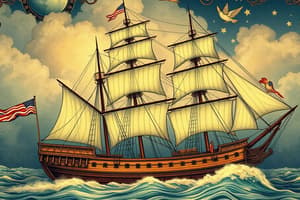Podcast
Questions and Answers
Which of the following are Three Major Responsibilities of vessels? (Select all that apply)
Which of the following are Three Major Responsibilities of vessels? (Select all that apply)
- Practice good seamanship (correct)
- Keep a proper lookout (correct)
- Maintain a safe speed (correct)
- None of the above
What is a give-way vessel?
What is a give-way vessel?
The vessel that is required to take early and substantial action to keep well away from other vessels.
What is a stand-on vessel?
What is a stand-on vessel?
The vessel that must maintain its course and speed unless it's clear the give-way vessel is not taking action.
A _______ vessel is one propelled by machinery, including a sailboat using an engine.
A _______ vessel is one propelled by machinery, including a sailboat using an engine.
A _______ vessel is defined as any vessel under sail and with no engine in use.
A _______ vessel is defined as any vessel under sail and with no engine in use.
What does it mean when two vessels are meeting head-on?
What does it mean when two vessels are meeting head-on?
What should the power-driven vessel do when crossing paths with a sailing vessel?
What should the power-driven vessel do when crossing paths with a sailing vessel?
Match the following light signals with their meaning:
Match the following light signals with their meaning:
A sailing vessel is always the stand-on vessel except when it is overtaking.
A sailing vessel is always the stand-on vessel except when it is overtaking.
What does 'restricted visibility' mean?
What does 'restricted visibility' mean?
What should be done during a risk of collision situation?
What should be done during a risk of collision situation?
The white light seen only from behind or nearly behind the vessel is called a _______.
The white light seen only from behind or nearly behind the vessel is called a _______.
What does a series of five (or more) short, rapid blasts signify?
What does a series of five (or more) short, rapid blasts signify?
Flashcards are hidden until you start studying
Study Notes
Three Major Responsibilities
- Practice good seamanship to ensure safe navigation and operation of the vessel.
- Keep a proper lookout to prevent collisions.
- Maintain a safe speed to allow for adequate stopping distance and reaction time.
Give-way Vessel
- Required to take early and substantial action to avoid other vessels.
- Should not cross in front of other vessels; changes in course or speed must be clearly visible.
Stand-on Vessel
- Must maintain its course and speed unless the give-way vessel is not taking appropriate action.
- Do not turn toward or cross in front of the give-way vessel.
Two Vessels Propelled
- Includes two power-driven vessels, two sailing vessels, or a mixture of both.
Two Vessels Approaching
- Meeting head-on: situation where vessels are nearly aligned.
- Crossing paths: vessels on a trajectory that poses collision risk.
- Overtaking: when a vessel approaches another from behind.
Definition of a Vessel
- Any watercraft capable of transportation on water, including seaplanes.
Power-driven Vessel
- Any vessel propelled by machinery, including those that utilize engines.
Sailing Vessel
- A vessel operated solely by sails without an activated engine.
Vessel Engaged in Fishing
- A vessel utilizing nets or equipment that limits maneuverability is considered engaged in fishing, excluding trolling activities.
Underway
- A vessel is considered underway when it is not anchored, tied to shore, or aground.
Risk of Collision (Power vs Power)
- Arises when approaching vessels maintain a constant collision course or when encountering large vessels.
Meeting Head On (Power vs Power)
- Neither vessel is designated as a stand-on; both should turn to starboard (right).
Paths That Cross (Power vs Power)
- The vessel on the operator's left (port) is the give-way vessel; the vessel on the right (starboard) is the stand-on vessel.
Overtaking
- The vessel performing the overtaking maneuver is the give-way vessel; the overtaken vessel remains the stand-on vessel.
Give-way Vessel
- Defined as the vessel needing to take action to avoid collision by stopping or altering course.
Stand-on Vessel
- Required to maintain its course unless it becomes evident that the give-way vessel is not acting appropriately.
Meeting Head On (Sail vs Power)
- The power-driven vessel is the give-way vessel; the sailing vessel remains the stand-on vessel.
Paths that Cross (Sail vs Power)
- The power-driven vessel is the give-way vessel, while the sailing vessel is the stand-on vessel.
Overtaking (Sail vs Power)
- The overtaking vessel, regardless of type, is the give-way vessel; the one being overtaken is the stand-on vessel.
Wind on Same Side
- The leeward vessel (downwind) is the stand-on vessel when sailing vessels approach each other with the wind on the same side.
Wind on Different Side
- The sailing vessel with wind on its starboard side is the stand-on vessel when approaching one another with the wind on different sides.
Leeward and Windward
- Leeward refers to the direction the wind is blowing towards; it pertains to vessels downwind of others.
- Windward indicates the direction from which the wind originates; it pertains to vessels upwind of others.
Meeting Head On (PWC vs PWC)
- Both vessels must turn to starboard as neither is the stand-on vessel.
Crossing Paths (PWC vs PWC)
- The vessel on the port side is the give-way vessel, while the starboard vessel is the stand-on vessel.
Overtaking (PWC vs PWC)
- The overtaking vessel is the give-way vessel, while the one being overtaken is the stand-on vessel.
Operator Of Power Give-Way Rules
- Certain vessels not under command or restricted in maneuverability must give way; this includes those engaged in commercial fishing.
Operator of Sailboat Give-Way Rules
- Similar rules apply, where vessels not under command, restricted, or engaged in commercial fishing must yield.
Engaged in Commercial Fishing
- Defined by use of equipment that restricts maneuverability, excluding trolling.
Restricted Visibility
- Weather conditions that impair visibility, such as fog, mist, rain, or snow.
Navigation Lights
- Sidelights are red (port) and green (starboard) visible from side and head-on.
- Sternlight is a white light visible from behind.
- Masthead light shines forward and is required on power-driven vessels.
- All-round white light can replace masthead and sternlights on smaller vessels.
Light Signals
- Different light combinations indicate vessel status and intent, such as overtaking, anchored, or stand-on positions.
- Short blasts signal passing intentions; prolonged blasts are used as warnings or sailing vessel signals.
General Safety Signals
- A series of rapid blasts indicate danger or confusion regarding intentions, guiding operators in navigation decisions.
Studying That Suits You
Use AI to generate personalized quizzes and flashcards to suit your learning preferences.




